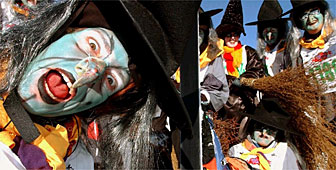Artist travels through Gruyères’ mythical past

A series of paintings by a Swiss-Australian artist exhibited at Gruyères castle is shedding light on the region's legends and myths.
In the hands of Lucienne Fontannaz, the landscape is dark and populated with sinister characters. Just like the stories.
“I realised that coming to Gruyères and talking to people here that there remained a memory of the legends that wasn’t quite the case in all areas of French-speaking Switzerland,” says Fontannaz.
Leaving her home in Australia, Fontannaz travelled around the Gruyères countryside last year to paint the landscapes where the stories unfolded.
She discovered during her conversations with cheese-makers and herdsmen that the oral tradition was still very much alive.
Fontannaz remembers one day looking for a particular pasture and entering a chalet to ask for directions.
“I explained the reason why and they invited me in and shared their lunch – cream and cheese – and it was wonderful speaking to these herdsmen,” she recalls.
Sacred song
“At a specific time of the lunch, everybody became very quiet and suddenly they started singing the Ranz des Vaches in the patois and it was so solemn – ceremonial if you want – it felt to me as though we were dealing with something sacred.”
To illustrate the story of the origin of the well-known alpine hymn, le Ranz des Vaches, Fontannaz used dark hues – blood reds and sinister browns.
The first picture is of a cauldron of the whitest milk, which, as the story goes, is stirred by three spirits who pay a nocturnal visit to the chalet of a herdsman.
Two of the spirits offer the man the choice between power and wealth. The third instead offers him a song, le Ranz des Vaches, which he accepts.
Custom survives
“Le Ranz des Vaches is a particular example of how a very old custom has survived and still touches us,” she adds.
“As the story is told, the young man receives the song and that song will stir the heart of every person from Gruyères and the whole country.”
In many ways the song, as a representation of Swiss folklore, has drawn Fontannaz back to Switzerland.
She has spent most of her adult life abroad, living, studying and working first in Canada and then in Australia, which she now calls home.
Her outsider’s perspective emboldened her to tackle clichéd images of the Swiss countryside and its people that other serious artists try to avoid.
Ghostly shepherds
But in the hands of Fontannaz, the rustic scenes of herdsmen, cheese-making and the surrounding mountains are anything but pretty. There are giants, ghostly shepherds and pastures that lead to hell.
“They deal with the good and the bad – the great concepts. But I suppose it was the drama of the stories that caught my attention.
“It’s this drama of the legends that has overridden the beautiful side of Gruyères,” Fontannaz continues.
“I have often thought that the representation of the mountains of Gruyères and many other places in the mountains through tourism gives an impression of something that is so lovely and sweet, whereas the real feeling of the mountains is one of power and can be quite menacing.”
Fontannaz says there are parallels in the oral traditions of many cultures, even between the Swiss and the Aborigines of Australia.
Gargantua
As portrayed in her series of pictures illustrating the story of “Gargantua”, the mountainous landscape of Gruyères was shaped by giants, as is described in the text (including an English version) accompanying the paintings:
“In pagan times, the inhabitants of Gruyères told stories about a giant, Gargantua. His head resembled an enormous rock. His nostrils and ears formed dark caverns.
“If he lay down, the impressions of his body stayed forever moulded into the ground. When he slept, his powerfully loud snores would provoke rock falls all around.”
Fontannaz says Australia’s Aborigines also believe powerful creatures left their indelible mark on the Australian landscape.
Fontannaz wants to return to Switzerland to work on a series of paintings to contrast the landscapes of Australia and Switzerland.
“The landscape of Australia is the oldest in world and the mountains in Switzerland are among the youngest, so I thought that would justify just looking at those two countries.”
swissinfo, Dale Bechtel
Gruyères castle is exhibiting a series of works by Swiss-Australian artist, Lucienne Fontannaz, highlighting nine legends of Gruyères.
The artist discovered during her travels in the region that the oral storytelling tradition has survived better in Gruyères than many other places in the French-speaking part of the Swiss Alps.
The exhibition runs until November 10.

In compliance with the JTI standards
More: SWI swissinfo.ch certified by the Journalism Trust Initiative












You can find an overview of ongoing debates with our journalists here . Please join us!
If you want to start a conversation about a topic raised in this article or want to report factual errors, email us at english@swissinfo.ch.